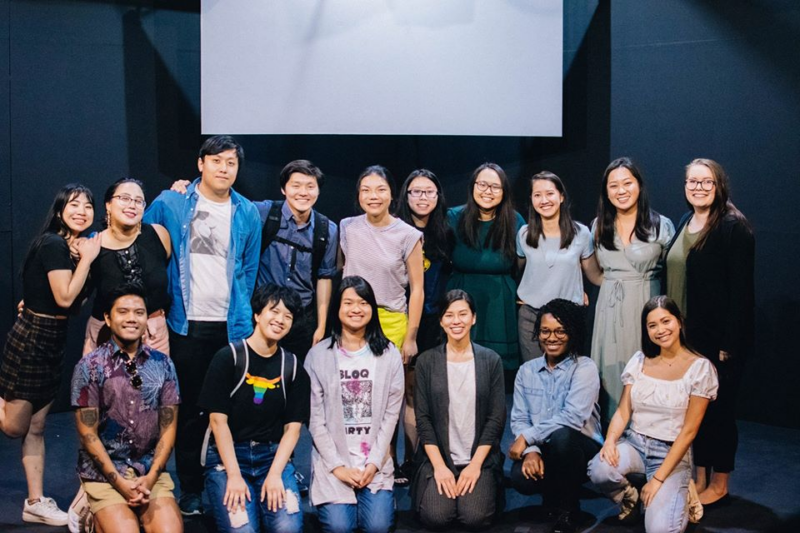
I’ve known Thanh Bui and Sandy Lam from my undergraduate time at The University of Texas At Austin. From a peripheral eye, I have seen their friendship and their creative collaborations grow. During an awkward transitionary period where I was trying to summon up the courage to pursue my own artistic dreams, they were forging their impressions onto the theater scene on campus. Heavily involved with the Asian American Culture Committee, Creative Arts + Theatre Committee, Students for Equity and Diversity, & Asians for Black Lives, both Thanh and Sandy were living, breathing Asian American creators leaving their mark on the stage and inspiring my own artistic path.
Now, as graduates, they have teamed up again to form Sad Girl Productions to present So Lucky, an original play with a majority Asian American cast, to be shown in Austin, Texas.
Ground Floor Theatre at 979 Springdale Rd #122
3/13, 3/14, 3/19, 3/20 at 7:30pm (doors open at 7pm)
3/15, 3/21 at 1:30pm (doors open at 1pm)
I had the pleasure of asking both Thanh Bui and Sandy Lam about the origins of their play, their creative processes, and their own thoughts on representation in the media. (The interview has been edited for length and clarity.)
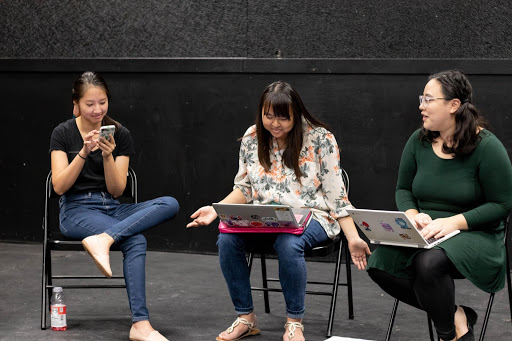
Joshua Nguyen: What is the story of So Lucky? How did the idea for So Lucky come about? Was it a life-long project, through a conversation, or from one particular moment?
Sandy Lam (Producer, Playwright, Assistant Director, Actress): So Lucky is the story of two stories. In the past, Pen Huang’s family is falling apart. In the present, Pen tries to bring her community together by planning her city’s first Lunar New Year Festival. The story covers APIDA (Asian Pacific Islander Desi American) issues such as mental health, intergenerational conflict, immigrant families, finding belonging, building communities, and growing up.
The first scene I ever wrote features a daughter telling her mother she doesn’t want to learn Chinese anymore (partially based on a real life experience with my own parents.) Writing that scene reminded me of how often I’d have conversations with my Asian American friends, especially those who were female, about how we felt disconnected from and misunderstood by our immigrant families and the world around us. We also all had some form of mental illness – depression, anxiety, PTSD, or others. Looking back now, I can say that attending Chinese School was really difficult for me as a socially anxious child, but I didn’t have the words to explain that when I was younger. So instead, I was labeled by my parents and teachers as unagreeable and ignorant.
But So Lucky is not a diagnosis. I think it’s inaccurate (and can potentially lead to harmful racial stereotyping) to say that our families are the cause of our mental health issues. I think it’s something more complex than that, something spanning over generations and seas. I wanted to create a space, not to point fingers, but to talk about all of it.
What do you think is the main takeaway from this production?
Thanh Bui (Director): To take notice, ask, and listen.
Where did the name Sad Girls Productions come from?
SL: I half remember having the conversation in a long car ride and the other half at our kitchen counter, but what I do remember concretely was that it was a joke at first. We had both graduated by then and post-grad life was miserable and lonely. It was (literally) the dark ages. We didn’t turn on the lights. We didn’t go out. We only talked to our cats. So when I asked myself what name would best capture who we were, “sad girls” is what came up in my mind. But even though it was a joke, it lingered around, caught on, and grew.
TB: It was either this or Sad Blobs Productions to be gender neutral.
What is the mission of Sad Girls Productions?
TB: To make art with the intention of fostering a culture of empathy, inclusivity, and creating space for those who come after us. Our team is comprised of people of color, womxn, nonbinary, and queer folks. We want to say things, make room, and build community.
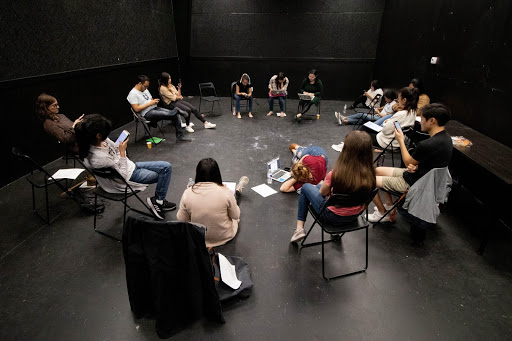
What barriers appear when working in very white production space? What is it like to work on a team of majority-POC?
SL: I feel like when I work with community partners, I always have this tiny voice of caution in the back of my mind. Can I trust this person? Are they going to treat me differently because of the way I look or present myself? Are they going to be an ally or a barrier? It’s not like I am pushing through a road of racists to get this play made, but that I can’t help but be wary due to previous experiences.
What I like about working with a majority POC production team is that everyone cares about creating bonds. This isn’t a business for us, and we believe that building a community in our cast is just as important as putting the damn show on. So we invest a lot of time in getting to know people, meeting them where they are, and taking into consideration everyone else’s life experiences.
With majority-POC productions, there’s an inherent understanding of who we are, what we face, and what we won’t do to each other.
TB: I can’t say that I’ve been in too many majority-white production spaces recently because I avoid them, but I can tell you as an Asian American actor in Austin that a lot of white creatives don’t know how to create welcoming spaces. It comes from an utter lack of understanding of what it’s like to be unseen or misrepresented. Time and time again, I’ll read casting calls and know immediately that a script was written by someone who can only conceive of themselves and their life. Naturally, that influences every part of the process, and those are the productions I skip on. With majority-POC productions, there’s an inherent understanding of who we are, what we face, and what we won’t do to each other. We care. So Lucky has a huge cast of predominantly APIDA actors (which is so rare!) and I don’t know when the next time will be that I get to work on something like this again so I’m going to use this opportunity to foster as much community and connection as I can for everyone involved.
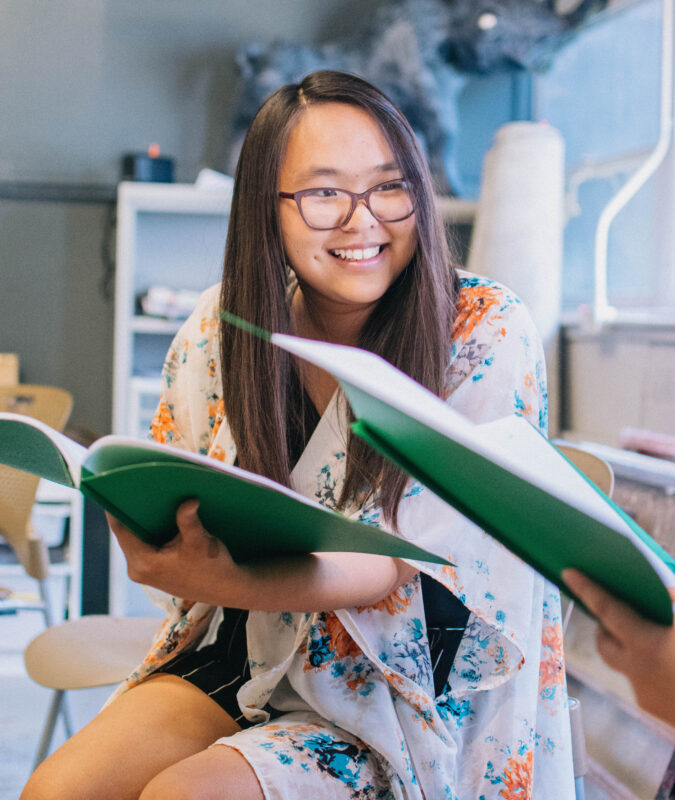
What challenges have you faced in the fundraising aspect of the production?
SL: There are a lot of kind and generous people out there, but there is not a lot of money. And it’s really hard to find a footing or support when you are a new company. How can we prove to people we are hardworking and talented enough to deserve grants and awards when this is our first go? Pretty much all of the funding we’ve secured so far is through our community of friends and family. This was also our first run, and most people advise that you fundraise first before starting on your project. We are doing both at the same time currently. Oops.
We also made the mistake of thinking people wouldn’t believe in us and set a really low goal on indiegogo. And then people believed in us so hard, we reached the goal we had set but… we still need a lot more money.
Things are also just ridiculously expensive. Our biggest expense is our rental space, and we are currently only able to afford it through financial sponsorship from Lucky Chaos. There is a space crisis in Austin and rent is high everywhere making it hard for new groups to put on shows.
TB: Let’s just say artists and their friends are not exactly rolling in riches. Let’s just say it can be hard to sell Asian American things to even Asian Americans (which is actually a plot point in the play aha ha).
SL: Speaking of which, here is a link to our indiegogo. Thanh pulled an all nighter to make it, so she requests you at least just look at it even if you don’t donate.
Has it been difficult navigating the Austin arts scene? Have you found the Austin scene welcoming, hostile, both?
SL: I’ve definitely left Austin art shows feeling detached and isolated – even though that’s the exact opposite of what art should do! I’ve performed at open mics a few times, only speaking when I am on stage, and then to nobody before leaving. I’m not sure what it is about Austin that makes me feel so alone as an artist. But [for ‘So Lucky’], it has been through the efforts of the community that So Lucky really got off the ground. We started by performing excerpts of the script at Lucky Chaos Productions‘ Groundworks event and hosting informal readings with friends at our apartment. At one point, all of our male actors were recruited through Thanh’s connections at Austin Bouldering Project. And now, Lucky Chaos is our biggest partner/collaborator (thank you, thank you Cindy and Leng for your support!)
TB: AHEM, LEMME TELL YOU. I’ll give Austin this, it’s a great place to get started. As a whole, the Austin arts scene is very supportive and collaborative. There aren’t as many barriers to entry for newcomers as you might find in other cities. However, everyone’s hustling. What I’ve encountered over and over again is that artists in Austin crave community, but there exists very few structures to sustain that. It’s easy to connect and collaborate once or twice but incredibly hard to form long lasting working relationships or even just friendships with other artists if you aren’t directly working with them frequently. And I get it. We all have our projects and we’re all a little overwhelmed wearing multiple hats and running to match the speed of our ideas and ambitions that sometimes community takes a backseat. I wouldn’t say that the Austin arts scene has ever been hostile, but I will say that it felt very detached and inaccessible at first. Then I learned that almost everyone else feels similarly. The tricky part is consistently making an effort to feel less of that. Together.

Did working with particular organizations during undergrad, I’m thinking about E+E (UT Austin’s Campus Events + Entertainment organization), help this undertaking? If so, what?
SL: In undergrad, I was super involved with the student events center (E+E). I specifically spent a lot of time with the Asian American Culture Committee and Creative Arts + Theatre Committee (I eventually chaired the CA+T committee.) There are actually bits of the show based on my experiences in both committees, haha.
Pretty much everything I’ve learned about event planning, theatre, and working with people, I learned through E+E. I was not a theatre major and I hadn’t been doing theatre all my life, but I’d found a space where I could do art with CA+T. Actually, that’s not accurate, CA+T is where I created an open, welcoming space for people to express themselves artistically. Because when I first joined the organization, I constantly felt like I didn’t belong and that I wasn’t good enough to be there. Eventually I climbed the ranks and threw a coup so I could craft the organization to be more inclusive, to create opportunities for those who are new to theatre, and to seek out diversity. Those are the things I took with me when we started up Sad Girls.
And now, most of the So Lucky cast + crew is actually current/former CA+T members (but we still love our non-E+E members dearly!) It makes me feel really fortunate I was a part of E+E and that the relationships I built during that time still mean something to people even though I graduated a few years ago.
TB: Working with the Asian American Culture Committee taught me a lot about where other Asian Americans’ social and political consciousness were because their perspectives were sometimes different from my own. In fact, the bond between Sandy and I is as strong as it is because we shared similar perspectives that we didn’t often find with other Asian Americans. This sentiment is very much embedded into the fabric of the play.
Creative Arts + Theatre saved me. I learned so much more about life, the stage, acting, loving, passing things on, magic, reciprocity, change, and acceptance than I could put into words. I will also credit working with Students for Equity and Diversity under the Multicultural Engagement Center at UT, becoming a minor in and working for the Center for Asian American Studies, and helping to found Asians for Black Lives at UT (may it rest in peace) all as pretty pertinent foundational work that’s helped inform my handling of the play and its materials. Basically, we did a lot of event coordinating in college.
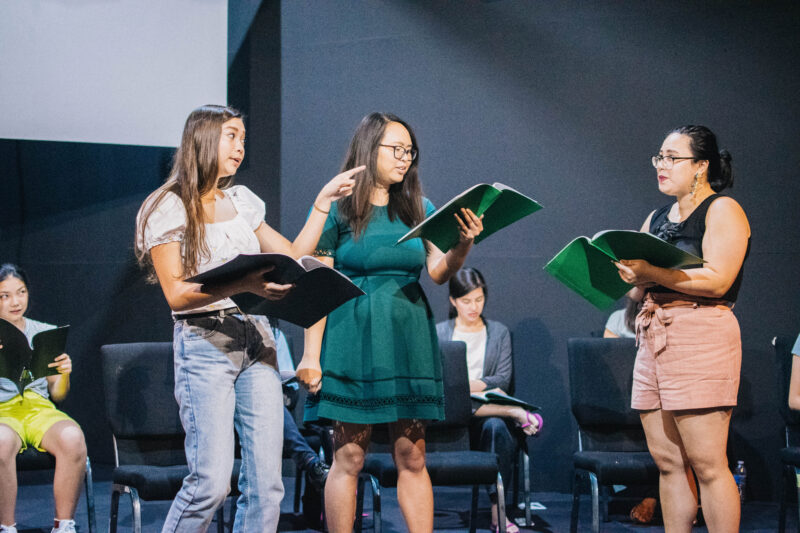
The show explores mental health, especially among Asian Americans, which is an issue that I’ve never personally seen addressed in the media, which is heartbreaking. Why do you think it is rare to find this issue portrayed in media?
SL: I think the silence about this issue comes from both the inside and the outside. Are we talking about it? Do we know how to talk about it? Do we have the space to talk about it? Will people listen? Will people understand?
One of the main challenges with this play is an ongoing question we’ve asked ourselves from the beginning: how do you depict mental health when it is often invisible?
TB: I think mental health is still stigmatized across all communities, especially communities of color, and not only is it difficult to talk about, it’s even harder to portray. One of the main challenges with this play is an ongoing question we’ve asked ourselves from the beginning: how do you depict mental health when it is often invisible? The stage is where some big, visible things occur, yet we are trying to show little things that can be very easily missed in real life, not just by audience members in the back. To answer your question, I think it’s rare to see mental health portrayed in media because it’s not easy to do. It requires care, attention, research, a bit of personal experience, and if done thoughtlessly, can cause more harm than it’s worth. For Asian Americans especially, there remains a lot of things we are still building language for around mental health. We are still figuring out how to tell our parents, we are still figuring out how to tell ourselves.
In what ways do you foster a sense of community among the cast and crew within this particular production? Are there any directing influences you pulled from? Are there any directing experiences you definitely did not want to do?
SL: I’ve definitely been in my fair share of terrible theatre spaces with bad directors. One time, I didn’t have all my lines perfectly memorized for a show, and the director made me redo the scene from the start, over and over again, every time I messed up. It was unnecessary, shamey, embarrassing, and didn’t actually solve the problem. Another time a director scoffed at my ability to perform a role because of their impression of me being too introverted/timid. Needless to say, these were examples of leaders I did NOT want to recreate.
When I wrote the script, I purposely left things about each character undetermined. So as we’ve cast people and learned about who they are, I’ve changed the characters’ names, pronouns, sexual orientations, backstories, hobbies, etc so that performers can bring in their own experiences.
TB: Unfortunately, a lot of my memories of theatre are tied to feeling sidelined or like I don’t belong. I think of cliques, personalities, egos, and power. Having been on the other end of that oblivion gives me a pretty good idea of what not to do. As for directing influences, oddly enough, the majority of the directors I’ve worked with have tended not to give very explicit direction in favor of whatever feels most honest so I’ve kinda been following suit. I’ve been incredibly lucky to have been directed almost exclusively by womxn, queer artists, and people of color. They’ve all trusted me and my instincts, and that goes a really long way for an actor. I’m not sure what people traditionally do with their cast and crew, but the public play reading of the script was a really magical and unexpectedly cathartic/healing day for us as well as the audience and it’d be a huge mistake not to create space for that again with our full production cast and crew. All that to say: I want to build in room to talk about our individual stories and our collective feels. It feels necessary in a space like this, with a group of people like this to discuss the stuff of real life that surrounds and goes into the story we’re telling.
How long did it take you to write this production? Were there any life specific experiences, either from your life or others, that make up the foundation of the script?
SL: I started to write in October 2018. The script was printed in December 2019 but… I am definitely still making small tweaks and edits as rehearsals continue.
The script goes back and forth between Pen’s past and present, and to create that I drew from my childhood and young adult life. There are a lot of scenes that are versions of arguments I’ve had with my parents or my friends but put into different bodies. But, yes, a lot of what happens is based on my own experiences. In college, I did help plan several Lunar New Year Festivals on campus. I had a hard time feeling like I belonged in any APIDA communities. I learned about and finally put labels to my mental illness. I felt lonely and hated myself. I found friends who were also trying to find themselves.
TB: I can vouch that real life moments sometimes get a second life in Sandy’s writing. Like memory zombies, but make it fashion.
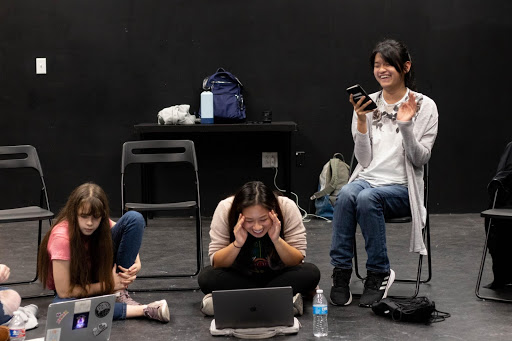
Were there any books/movies/music that influenced the writing of the play?
SL: A lot of the humor is pulled from Tumblr and 90s cartoons/shows. (I was actually recently accused of using references that are “too old” from some of our younger cast members lolol.) I think the shape, beliefs, and values of the show are partly influenced by Steven Universe and One Day at a Time. Both shows are pretty quirky and sit in the middle of sad and happy.
Writing wise, one of my favorite authors is Melina Marchetta who writes a lot of family dramas that intersect with culture and mental health. Saving Francesca and On the Jellicoe Road are some of my favorite books. She also plays around a lot with time. The events don’t always unfold in chronological order in her books and neither do they in the play. Her books also have an element of magical realism, which I somewhat emulate in my depiction of Pen’s anxiety. I also love the found family trope, pretty much all of my favorite works have this.
In terms of staging and movement, I’ve also been obsessed with the Broadway musical Hadestown for the past year (poor Thanh has to listen to me sing it all the time.) Their entire creative leadership team is female, and I got to watch it last summer. I was inspired by how out of the box and creative they were with how they used space. After I watched it, I asked Ken (our Set/Props director) if they could build me a rotating stage. They said no, and I can respect that.
Do you have any critiques of recent Asian American media (Crazy, Rich, Asians, Always Be My Maybe, All The Boys I’ve Loved Before, etc.)? Do you find certain critics more fair than others or is it because there isn’t a big enough sample size?
SL: I have a love/hate relationship with a lot of new APIDA media, because some of it is good but most of it I don’t relate to or are written for white audiences. But the fact that they are being made and watched? The fact that Awkwafina has blown up? That’s pretty amazing. And if white people can have a million sappy rom coms, so can we. I am still waiting for a movie, book, or story that makes me feel seen and represented – but maybe we get there by first saturating the market with as many APIDA stories as we can so that we can push more through the gate.
TB: I’m going to echo Sandy and say that the stories I crave still haven’t been written. When Crazy Rich Asians and To All The Boys I’ve Loved Before came out in the same year, I was perplexed. It’s like I’ve waited so long to be represented on the screen for this? I enjoyed the movies, of course, but I couldn’t relate to them in the ways I thought I’d be able to. And then it hit me: we’re seeing these narratives first because these are the ones that sell. They sell because they appeal to wide (read: white) audiences. Of course these stories aren’t going to be incredibly meaningful to me because the stuff that’s meaningful to me isn’t very sellable yet. But we needed these stories to open the door.
When creating this production, do you worry about the story resonating with Asian Americans AND non-Asian Americans?
SL: I always worry.
I wanted to be very careful when I wrote some of the characters, especially the Mother character. She had to be restricting, but I didn’t want her to come across as needlessly strict or unsympathetic (see: tiger mom.) There was a scene where Pen and the Mother are arguing about Pen’s future career (basically all the Pen/Mother scenes are arguments lolol) and when I was zipping through the early drafts I’d made a reference about the Mother wanting Pen to become a lawyer or doctor. It wasn’t even written as a joke, but in later drafts I removed it. I was scared that just the slightest mention would suddenly make the audience, both Asian and non Asian, think, “Oh, I’ve seen this before. I’ve heard this before. All Asian parents care about is churning out doctors lol. They suck lol.”
But there are other more important things going on in that scene, in between and underneath the lines. It’s not just about the Mother pressuring Pen to take on a prolific job, it’s a mother worried about her daughter’s ability to survive in the real world and a daughter who feels rejected by her mother. All of this thinking just to remove 1 line from the script.
Of course, I know that I can’t control how the audience will react and I didn’t write the show to teach people how to be less ignorant. There will undoubtedly be people who watch this and not get it. But we also had a lot of people of various different backgrounds come out to watch the public table read, and a lot of them cried. I am here to collect the tears of people like that >:)
TB: Sandy told me once that your work will find the people it’s meant for. (SL: I did!?)
I’ve thought about this, and ultimately I don’t worry about whether the story will resonate with Asian Americans or non-Asian Americans. At the end of the day, our job is to tell a good story and an honest story: our story. Don’t get me wrong, I am extremely aware of the messages we put out and the weight of portraying Asian Americans publically and artistically- especially in a city like Austin- but as we’ve learned from films like Crazy Rich Asians, there is no singular narrative that’s going to resonate with all Asian Americans and there shouldn’t be. As for non-Asian Americans, I’ve seen a lot of Asian American artists create for everyone. The cost of that is there exists a young child somewhere out there craving to find home on a page, a screen, a stage only to find houses shared with strange people who do not see them. I was once and still am that child.
Follow their social media for updates on ‘So Lucky’:
Twitter and IG: @sadgirlspro
facebook.com/sadgirlsproductions
Contributor Bios
Thanh Bui was born in Saigon and raised in Boston and Houston. She is a writer and actor based in Austin, Texas. Her written work has appeared in The Sunlight Press, Glass: A Journal of Poetry, FIVE:2:ONE, Cosmonauts Avenue, The Offing, and FreezeRay Poetry. She enjoys puzzles, climbing, and learning new things.
Sandy Lam is a storyteller and nonprofit professional in Austin, Texas. “So Lucky” is her third play to hit the stage. Some of her previous credits include “How to be Super” (playwright, composer, director) and “Speak no Evil” (playwright) from the 36th Annual Madrigal Dinner. She is also a musician and reads tarot cards.
Joshua Nguyen is a Kundiman Fellow, collegiate national poetry slam champion (CUPSI), and a native Houstonian. He has been published in The Offing, The Acentos Review, Rambutan Literary, Button Poetry, The Texas Review, Auburn Avenue, Crab Orchard, Gulf Coast, and Hot Metal Bridge. He is currently an MFA candidate at The University of Mississippi. He is a bubble tea connoisseur and works in a kitchen. Twitter & Instagram at @joshuanguyen03. joshua-nguyen.com


